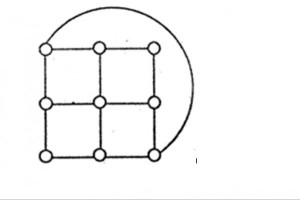Question

a.
2
b.
3
c.
4
d.
5
Posted under GATE cse question paper Engineering Mathematics
Engage with the Community - Add Your Comment
Confused About the Answer? Ask for Details Here.
Know the Explanation? Add it Here.
Q. What is the chromatic number of the following graph?
Similar Questions
Discover Related MCQs
Q. A binary operation on a set of integers is defined as x y = x^2 + y^2. Which one of the following statements is TRUE about ?
View solution
Q. Consider the set S = {1, ω, ω^2}, where ω and w^2 are cube roots of unity. If * denotes the multiplication operation, the structure (S, *) forms
View solution
Q. Which one of the following in NOT necessarily a property of a Group?
View solution
Q. Consider the binary relation R = {(x, y), (x, z), (z, x), (z, y)} on the set {x, y, z}. Which one of the following is TRUE?
View solution
Q. Let S be a set of n elements. The number of ordered pairs in the largest and the smallest equivalence relations on S are:
View solution
Q. How many different non-isomorphic Abelian groups of order 4 are there
View solution
Q. Let X, Y, Z be sets of sizes x, y and z respectively. Let W = X x Y. Let E be the set of all subsets of W. The number of functions from Z to E is:
View solution
Q. The set {1, 2, 3, 5, 7, 8, 9} under multiplication modulo 10 is not a group. Given below are four plausible reasons. Which one of them is false?
View solution
Q. A relation R is defined on ordered pairs of integers as follows: (x,y) R(u,v) if x < u and y > v. Then R is: Then R is:
View solution
Q. Let S denote the set of all functions f: {0,1}^4 -> {0,1}. Denote by N the number of functions from S to the set {0,1}. The value of Log2Log2N is ______.
View solution
Q. Consider the following relation on subsets of the set S of integers between 1 and 2014. For two distinct subsets U and V of S we say U < V if the minimum element in the symmetric difference of the two sets is in U. Consider the following two statements:
S1: There is a subset of S that is larger than every other subset.
S2: There is a subset of S that is smaller than every other subset.
Which one of the following is CORRECT?
View solution
Q. Let G be a group with 15 elements. Let L be a subgroup of G. It is known that L != G and that the size of L is at least 4. The size of L is __________.
View solution
Q. If V1 and V2 are 4-dimensional subspaces of a 6-dimensional vector space V, then the smallest possible dimension of V1 ∩ V2 is ______.
View solution
Q. There are two elements x, y in a group (G,∗) such that every element in the group can be written as a product of some number of x's and y's in some order. It is known that
x ∗ x = y ∗ y = x ∗ y ∗ x ∗ y = y ∗ x ∗ y ∗ x = e
where e is the identity element. The maximum number of elements in such a group is __________.
View solution
Q. Consider the set of all functions f: {0,1, … ,2014} → {0,1, … ,2014} such that f(f(i)) = i, for all 0 ≤ i ≤ 2014. Consider the following statements:
P. For each such function it must be the case that
for every i, f(i) = i.
Q. For each such function it must be the case that
for some i, f(i) = i.
R. Each such function must be onto.
Which one of the following is CORRECT?
View solution
Q. Let E, F and G be finite sets. Let X = (E ∩ F) - (F ∩ G) and Y = (E - (E ∩ G)) - (E - F). Which one of the following is true?
View solution
Q. Given a set of elements N = {1, 2, ..., n} and two arbitrary subsets A⊆N and B⊆N, how many of the n! permutations π from N to N satisfy min(π(A)) = min(π(B)), where min(S) is the smallest integer in the set of integers S, and π(S) is the set of integers obtained by applying permutation π to each element of S?
View solution
Q. Let A, B and C be non-empty sets and let X = (A - B) - C and Y = (A - C) - (B - C). Which one of the following is TRUE?
View solution
Q. The set {1, 2, 4, 7, 8, 11, 13, 14} is a group under multiplication modulo 15. The inverses of 4 and 7 are respectively
View solution
Q. Let R and S be any two equivalence relations on a non-empty set A. Which one of the following statements is TRUE?
View solution
Suggested Topics
Are you eager to expand your knowledge beyond Engineering Mathematics? We've curated a selection of related categories that you might find intriguing.
Click on the categories below to discover a wealth of MCQs and enrich your understanding of Computer Science. Happy exploring!








